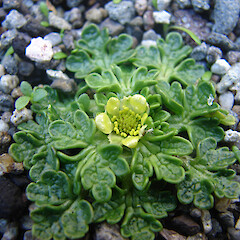Ranunculus recens
Synonyms
None
Family
Ranunculaceae
Flora category
Vascular – Native
Endemic taxon
Yes
Endemic genus
No
Endemic family
No
Structural class
Herbs - Dicotyledons other than Composites
NVS code
The National Vegetation Survey (NVS) Databank is a physical archive and electronic databank containing records of over 94,000 vegetation survey plots - including data from over 19,000 permanent plots. NVS maintains a standard set of species code abbreviations that correspond to standard scientific plant names from the Ngä Tipu o Aotearoa - New Zealand Plants database.
RANREC
Chromosome number
2n = 48
Current conservation status
The conservation status of all known New Zealand vascular plant taxa at the rank of species and below were reassessed in 2017 using the New Zealand Threat Classification System (NZTCS) – more information about this can be found on the NZTCS website. This report includes a statistical summary and brief notes on changes since 2012 and replaces all previous NZTCS lists for vascular plants.
Please note, threat classifications are often suggested by authors when publications fall between NZTCS assessment periods – an interim threat classification status has not been assessed by the NZTCS panel.
- Conservation status of New Zealand indigenous vascular plants, 2017 . 2018. Peter J. de Lange, Jeremy R. Rolfe, John W. Barkla, Shannel P. Courtney, Paul D. Champion, Leon R. Perrie, Sarah M. Beadel, Kerry A. Ford, Ilse Breitwieser, Ines Schönberger, Rowan Hindmarsh-Walls, Peter B. Heenan and Kate Ladley. Department of Conservation. Source: NZTCS and licensed by DOC for reuse under the Creative Commons Attribution 4.0 International licence.
2017 | Threatened – Nationally Vulnerable | Qualifiers: CD, RR, Sp, St
Previous conservation statuses
2012 | Threatened – Nationally Vulnerable | Qualifiers: RR, Sp, St
2009 | At Risk – Declining | Qualifiers: St, Sp
2004 | Gradual Decline
Distribution
Endemic to the North, South and Stewart Islands. In the North Island only known from one site in the Moawhango, and from the south Taranaki coastline. In the South Island known from North West Nelson, and the Otago and Foveaux Stait coastline. Local at Masons Bay on Stewart Island. Past records from the Chatham Islands remain unconfirmed and modern field surveys suggest they result from misidentification of seedlings of an complex of unnamed buttercups allied to R. foliosus and R. royi.
Habitat
Mainly coastal but also alpine in one North Island location. A species of turf and peaty soils developed over freshwater seepages.
Wetland plant indicator status rating
Information derived from the revised national wetland plant list prepared to assist councils in delineating and monitoring wetlands (Clarkson et al., 2021 Manaaki Whenua – Landcare Research Contract Report LC3975 for Hawke’s Bay Regional Council). The national plant list categorises plants by the extent to which they are found in wetlands and not ‘drylands’. The indicator status ratings are OBL (obligate wetland), FACW (facultative wetland), FAC (facultative), FACU (facultative upland), and UPL (obligate upland). If you have suggestions for the Wetland Indicator Status Rating, please contact: [Enable JavaScript to view protected content]
FAC: Facultative
Commonly occurs as either a hydrophyte or non-hydrophyte (non-wetlands).
Detailed description
Tufted, non-rhizomatous herb forming small circular appressed patches 10-50 mm wide. Petiole broad, flat, usually hairy. Leaves yellow-green, dark green, sometimes blotched or entirely chocolate brown, ovate, 3-lobed to about 1.2 toward base, lobes crenate or shallowly pinnatifid, 8-15(-20) mm, sparsely hairy on margins or glabrous. Flowers solitary, 8-10 mm diam., sessile, or rarely on short hairy scapes. Sepals spreading, sparsely hairy. Petals 5, yellow, linear-oblong, nectary single, 0.5 mm from petal base, with very small scale. Receptacle hairy. achenes 30-60, somewhat flattened, glabrous, brick red with dark tips; beak curved 0.5 mm long.
Similar taxa
A very distinctive plant not easily confused with any other indigenous or naturalised buttercup. It is not closely allied to R. ranceorum, which is a smaller plant of inland southern lake turfs, with quite different, smaller leaves, flowers and chromosome number. Although R. recens shows some distinctive variation with regard to leaf colour this does not seem to be, by itself, worthy of further taxonomic segregation.
Flowering
(September-)- October-November
Flower colours
Yellow
Fruiting
October -January(-April)
Propagation technique
Easy from fresh seed and remarkably tolerant of most soils and light levels provided plants are well watered. In humid climates plants suffer from powdery mildew.
Threats
A turf species most at risk from weeds and physical damage through trampling by stock and human traffic.
Etymology
ranunculus: From the Latin ‘rana’ frog, meaning little frog and probably refers to the plants typical marshy habit where frogs abound
Where To Buy
Not commercially available.
Attribution
Fact Sheet prepared by P.J. de Lange (30 August 2003). Description based on Allan (1961), Webb et al. (1988) and fresh specimens - see also de Lange & Murray (2008).
References and further reading
Allan, H.H. 1961: Flora of New Zealand. Vol. I. Wellington, Government Printer
de Lange, P.J.; Murray, B.G. 2008: Ranunculus ranceorum, a new name and rank for Ranunculus recens var. lacustris G.Simpson, an elusive, rarely seen buttercup of the Fiordland lakes, South Island, New Zealand. New Zealand Journal of Botany 46: 1-11.
Webb, C.J.; Sykes, W.R.; Garnock-Jones, P.J. 1988: Flora of New Zealand. Vol. IV. Christchurch, DSIR Botany Division.
NZPCN Fact Sheet citation
Please cite as: de Lange, P.J. (Year at time of access): Ranunculus recens Fact Sheet (content continuously updated). New Zealand Plant Conservation Network. https://www.nzpcn.org.nz/flora/species/ranunculus-recens/ (Date website was queried)













